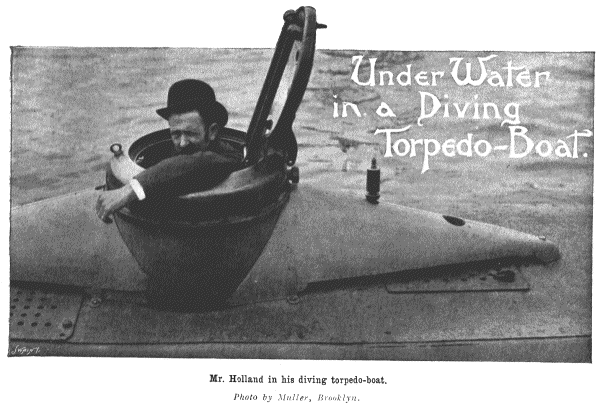

SOME of our acquaintances who knew that we were about to make a trip under water in the submarine boat Holland, asked us, more in earnest than their half-jocular manner would indicate, if we had made our wills. Others shrugged their shoulders, and said they wouldn't go under water in that or any other similar craft for any amount of money or experience. Still others, those who knew something about marine architecture and especially about submarine boats, said that of course it was safe enough, but something might happen, and, anyway, no married men ought to take chances. But when we got back without visible wear or tear to our nervous systems, all these acquaintances met us with smiles and inquiring looks, and said: " Tell us what it was like."
It will doubtless surprise most people to learn that it is more impressive to see the Holland go under water than to go under water in the craft itself. When one stands on a tugboat and watches the boat clip its nose into the water and gradually slide out of sight, until only the flags on the tops of the slender masts remain above water; and then, when one sees these flags disappear also, it sets the imagination at work in a lively fashion.
If the boat remains out of sight for twenty minutes or half-an-hour, the nerves of the observer are likely to make a large demand on his powers of self-control; and if the boat stays beneath the surface for an hour, as it actually did one day last spring in the bay of lower New York harbour when a heavy sea was running, and two tugboats loaded with people were unable to find it the four times it popped its turret above water, the excitement becomes still greater, and there is a corresponding relief and pleasure when, at last, the boat emerges and shrieks with its tiny whistle, and sports about on the surface, proving that, after all, it is completely under the control of its operator.
When you go down yourself under water in the Holland, the situation is far different. There is a certain tremulous feeling as you climb down the barrel-like turret and find yourself in a brightly-lighted steel cave that tapers off at one end in a constantly narrowing circle to the place where a slender shaft thrusts itself outside to a propeller, and, at the other end, stops short in a blunt compartment into which one cannot look without stooping.
The man who works the boat stands in the turret, and only his legs, as he stands on a bench, can be seen by those who are down in the body of the boat. You hear the top of the turret clamped down, and then you look about somewhat nervously to see what is to be done next. The pilot or commander in the turret rings a little bell, and one of the five men in the crew turns a wheel, and you see that the boat is under way, running along the surface.
One of the crew is far in the stern, where the gasolene engine and the electrical' appliances are. Another is near the centre, where there are two long levers, by which he fills or empties the big water-tanks in the bottom of the boat. Another lies stretched on the bottom of the main compartment, or sits on a camp stool, with his hand reaching up into the turret, where he turns a wheel that controls the diving engine. Another tucks himself into the small compartment at the bow, where he controls the apparatus for filling or emptying more tanks.
You look up at the tiny deadlight over your head, as you sit on your camp-stool, and you see the water dash over the glass in little waves. You hear the man in the turret give some order to the man at his feet; the floor tips slightly, and you know the descent has begun. You are so interested that nervousness has disappeared. Someone calls attention to a gauge over your shoulder, a glass tube containing a column of mercury, which shows the exact depth to which the boat has dived. You are intent on watching that when suddenly you look at the deadlight again. You see it covered with water of a most vivid green colour, and then your eyes go back to the gauge.
In a moment you begin to watch the crew, and to listen attentively to the orders that are given. The man under the turret turns a wheel. The bow of the boat lifts a little, and the gauge shows that you are coming to the surface again. The green covering slips away from the dead light, and finally disappears, and you know that you are once more running along the surface.
A bell sounds with some order from the turret. You look up, and find the deadlight covered again. The boat is going down without dipping. The gauge shows that, but there is no sinking sensation. The reserve buoyancy is being overcome by filling the tanks. Another bell is rung, and you know you are under way once more. The gauge tells you that the flags on the standards are fluttering along 'the surface, and the steady rumble and chuggedy-chug throb of the electric motor tells you that you are moving steadily.
There is nothing to see but a little compartment filled with machinery, in which a few men half creep about and turn this or that wheel, or push this or that lever, with entire complacency, and no evidence of hurry or alarm. Conversation in low tones is going on whenever there is anything of special moment to be talked about. Every move that the boat makes shows that it is under perfect control, and a feeling of entire safety takes possession of you.
In a few minutes the sensation of being under water becomes commonplace, and you begin to pity the people on the tugboat following you, and who are perhaps worrying lest some dire thing will happen to you. Except for the cramped quarters the sensation is practically the same as being in the engine-room of a liner at sea, fifteen or twenty feet below the surface of the water.
Three dives and a run under water of nearly three miles constituted the performance of the boat on the day we went down. After a little more than twenty minutes, we were on the surface again. The turret was unclamped, the air rushed down into the compartment, and the heavy feeling on the ear-drums for an instant showed that we had been breathing an atmosphere with a pressure slightly different from that on the surface of the water. The Holland, often called the "Monster War Fish," " Uncle Sam's Devil of the Deep," and the like, is, strictly speaking, a torpedo; but a torpedo controlled in all its workings by human agency inside the craft, instead of being automatic in its operations. The ordinary torpedo, by an arrangement of springs to counteract the water pressure, is made to go through the water at any depth set for it. It has to go in a path fixed for it beforehand. When it has run its course, it comes to the surface or sinks, in accordance with a predetermined plan. The Holland has men inside it to control it at will, from moment to moment, and with the additional power to discharge automatic water torpedoes, and to hurl aerial torpedoes as well.
The Holland is fifty-three feet long, and in its widest part it is ten and one-quarter feet in diameter. It has a displacement of seventy-four tons, and what is called a reserve buoyancy of two-tenths of a ton.
The frames of the boat are exact circles of steel. They are set a little more than a foot apart. They diminish gradually in diameter from the centre of the boat to the bow and stern. On the top of the boat a flat superstructure is built, to afford a walking-platform, and under this are spaces for exhaust pipes and for the external outfit of the boat, such as ropes and a small anchor. The steel plates which cover the frames are from one-half to three-eighths of an inch in thickness. From what may be called the centre of the boat a turret extends upwards through the superstructure about eighteen inches. It is about two feet in diameter, and is the only means of entrance to the boat. It is the place from which the boat is operated. At the stern is an ordinary three-bladed propeller and an ordinary rudder, and in addition there are two horizontal rudders —" diving-rudders," they are called—which look like the feet of a duck spread out behind as it swims along the water.
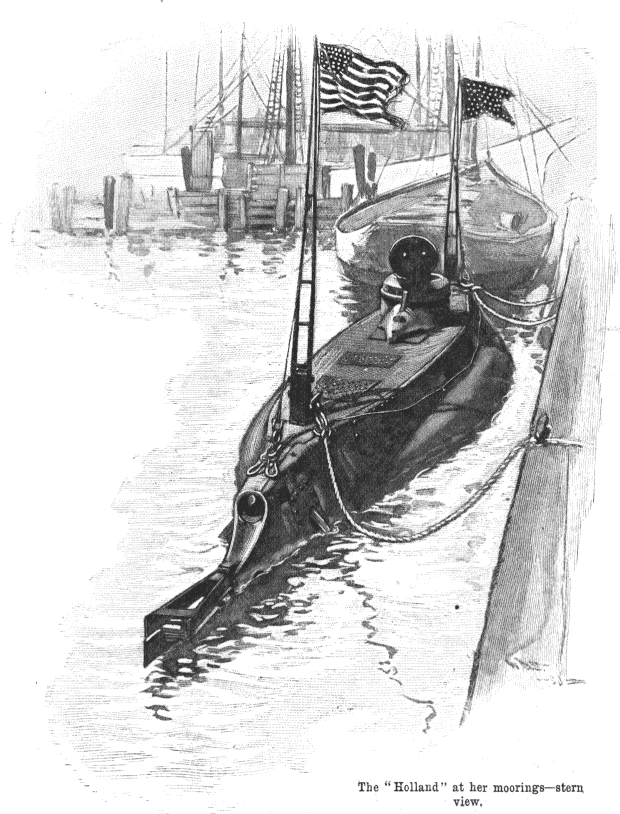
The boat is propelled on the surface of the water by a gasolene engine, and beneath the surface by electricity from storage batteries. From the bow two-thirds of the way to the stern there is a flooring, beneath which are the storage batteries, the tank for the gasolene. and the tanks which are filled with water to submerge the boat. In the last third of the boat the flooring drops away, and the space is occupied by the propelling machinery.
There are about a dozen openings in the boat, the chief being three Kingston valves, by means of which the submerging tanks are filled or emptied. Others admit water to pressure gauges which regulate or show the depth of the vessel under water. There are twelve deadlights in the top and sides of the craft. To remain under water the boat must be kept in motion, unless an anchor is used. There is always a reserve buoyancy which tends to make it come to the surface.

It can be steered to the surface by the diving-rudders, or sent flying to the top through emptying the storage tanks. If it strikes bottom, or gets stuck in the mud, it can blow itself loose by means of its compressed air. It cannot be sunk unless pierced above the flooring. It has a speed capacity of from eight to ten knots, either on the surface or under water.
It can go 1500 miles on the surface without renewing its supply of gasolene. It can go fully forty knots under water without coming to the surface, and there is enough compressed air in the tanks to supply a crew with fresh air for thirty hours, if the air is not used for any other purpose, such as emptying the submerging tanks. It can dive to a depth of 20ft. in eight seconds.
The interior is simply packed with machinery. As you climb down the turret, you are confronted with it at once. There is a diminutive compass, which must be avoided carefully by the feet. A pressure-gauge is directly in front of the operator's eye as he stands in position. There are speaking-tubes to various parts of the boat, and a signal bell to the engine-room.
As the operator's hands hang by his sides, he touches a wheel on the port side, by turning which he steers the little vessel, and one on the starboard side, by turning which he controls the diving machinery. After the turret is clamped down, the operator can look out through little plate-glass windows, about tin. Wide and 3in. long, which encircle the turret.
So long as the boat is running on the surface, these are valuable, giving a complete view of the surroundings, if the water is smooth. After the boat goes beneath the surface these windows are useless; it is impossible to see through the water. Steering must be done by compass, until recently considered an impossible task in a submarine boat. A tiny electric light in the turret shows the operator the direction in which he is going, and reveals the markings on the depth gauges. If the boat should pass under an object, such as a ship, a perceptible shadow would be noticed through the deadlights, but that is all. The ability to see fishes swimming about in the water is a pleasant fiction.
The only clear space in the body of the boat is directly in front of the bench on which. the man in the turret is standing. It is where the eighteen-inch torpedo tube and the eight and five-eighths inch aerial gun are loaded.
Along the sides of this open space are six compressed-air tanks, containing thirty cubic feet of air, at a pressure of 2000 pounds to the square inch. Near by is a smaller tank, containing three cubic feet of air at a fifty-pounds pressure. A still smaller tank contains two cubic feet of air, at a ten-pounds pressure. These smaller tanks supply the compressed air which, with the smokeless powder, is used in discharging the projectiles from the boat.
Directly behind the turret is where one finds the machinery packed away closely. Up against the roof on the port side is the little engine by which the vessel is steered: it is worked by compressed air. Fastened to the roof on the starboard side is the diving- engine, with discs that look as large as dinner plates stood on edge at each end. These discs are diaphragms on which the water pressure exerts an influence, counteracting certain springs which are set to keep the diving-rudders at a given pitch, and thus insuring an immersion of an exact depth during a run.
At one side is a cubic steel box—the air compressor ; and directly in the centre of this part of the boat is a long pendulum, just as there is in the ordinary torpedo, which, by swinging backwards and forwards as the boat dives or rises, checks a tendency to go too far down or to come up at too sharp an angle. On the floor are the levers which, when raised and moved in certain directions, fill or empty the submerging tanks. On every hand there are valves and wheels and pipes in such apparent confusion as to turn a layman's head.
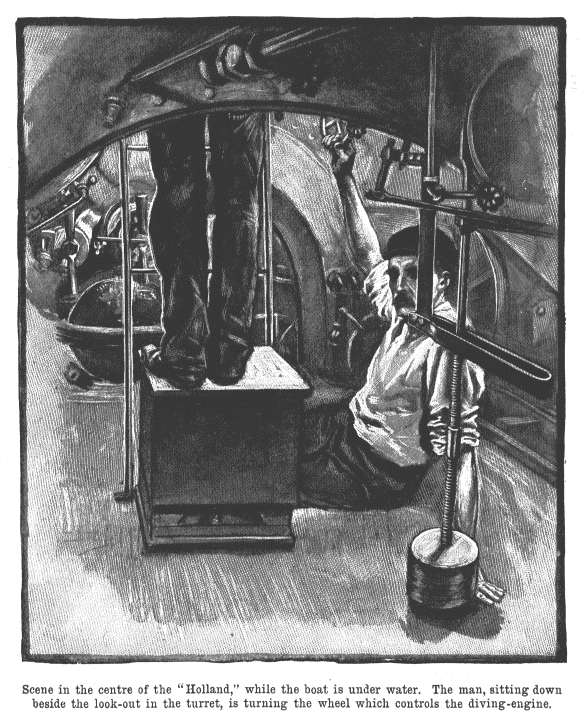
Further back in the boat, where the flooring above the tanks ends, is the engine-room. There are also pumps in the boat, a ventilating apparatus, and a sounding contrivance, by means of which the channel is picked out when running under water. This sounding contrivance consists of a heavy weight attached to a piano wire passing from a reel out through a stuffing-box in the bottom of the boat. There are also valves which release fresh air to the crew, although in ordinary runs of from one-half to one hour this is not necessary, the fresh air received from the 'various exhausts in the boat being sufficient to supply all necessities in that length of time.
It is easy to build up stories, products of the imagination, as to what such a boat as the Holland would do in action; but nothing definite and sure can be said until an actual test comes. There is, however, one undoubted service that a boat like the Holland could be made to render in war, and that is, preventing an effective blockade of a harbour.
The mere presence of such a boat defending a port would keep blockading ships moving at almost full speed, in order to be safe against its stealing near them while it was submerged, and blowing them to pieces ; and this movement would carry them probably so far off shore as to permit blockade-runners to get in and out easily.
Again, such a boat, if in proper working order, could enter a harbour despite floating mines, and could ruin a fleet penned in as Cervera's fleet was. It could travel below contact mines, and there would be no use in attempting to destroy it by exploding mines planted in the mud, because the operators of the mines, in the look-outs on shore, could not see the craft, and would not know when to set off such mines. In other words, the chief value of the Holland, as a development in warfare, will be to prevent blockades, and to increase that tension among officers and crews on an enemy's warship, or fleet of ships, that leads in time to complete demoralisation.
In an actual fight between a battleship and a Holland boat, the operation of the latter would be comparatively simple. The Holland would have a Whitehead torpedo in its bow tube ready for service, and also a projectile in its aerial gun ready to be fired. The boat would sink so that only its turret would remain above water, and so get within about a mile of its antagonist. So small an object as the turret could not be made out at that distance; and, even if it were made out, the result would probably be a panic on the larger boat.
Dipping beneath the water, the Holland would probably approach within a quaver of a mile, and then come up for another look of a second or two. If it was in the night, it might approach nearer, and when within 200 yards, could discharge its Whitehead torpedo with a fair certainty of hitting the target, especially if the boat had not yet been seen. If the Holland's presence had been detected, the big battleship would simply run away at full speed. No other course would be open to it.
With one torpedo fired from the Holland, the crew would simply place another in the discharging-tube. The operator would slowly raise the boat to the surface, get a line on his target, quickly turn the boat so as to be in a straight line of action, give a sharp command and then, as the boat was submerged by filling its tanks, another torpedo would be on its deadly errand. If the boat should be seen, and an attempt should be made to run it down, a dive would put it out of harm's way in ten seconds.
The chance of destroying it by a torpedo. would be very small, because it presents hardly any target; and this is also true of the chance of hitting it with shots from a warship's guns. If the submarine boat's. presence were suspected, the battleship would have to be kept running at nearly full speed, and at a long distance from port all of the. time; if its presence were not suspected, the work of destroying the battleship would not be difficult. In either case, the safety of the port would be assured.
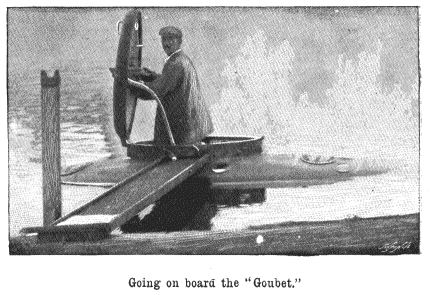
The Holland is probably the most perfect submarine boat yet devised, but it must not be supposed that the United States is the only country which has interested itself in submarine navigation. The British Government certainly have done little to encourage experiments in this direction, but the French have, for many years, owned submarine boats. which have proved more or less successful.
The Goubet, called after its inventor, M. Goubet, has been perhaps the best known of these, and it is to M. Goubet's courtesy that. we are indebted for the photographs of his boat, which we reproduce, and for the details. we are able to give concerning it.
The Goubet is a spindle-shaped vessel, 26ft. 3in. long, with a hull of bronze formed of a series of broad rings bolted together. Along the belly of the spindle runs a finlike keel, and there are somewhat similar fins at the sides. Upon these lateral fins rest skeleton tubes or guides for the holding and launching of auto-mobile torpedoes. At the rear end of the spindle is a screw.
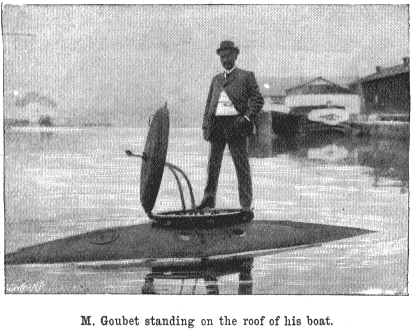 M. Goubet prides himself on the apparatus he has devised for the submersion of his craft, this being effected by the introduction of water into, and expulsion of water from, reservoirs in the hull.
M. Goubet prides himself on the apparatus he has devised for the submersion of his craft, this being effected by the introduction of water into, and expulsion of water from, reservoirs in the hull.
By the aid of an optical tube, which a pneumatic-telescopic apparatus enables the operator to thrust above the surface and pull down in a moment, the captain of the Goubet can, when near the surface of the water, see what is going on all around him. His telescope has a system of prisms and lenses which cause the image of the sea surface to be deflected down to the eye of the observer below, the object glass above being no bigger than a crown piece and therefore no target for the enemies' guns.
Fresh air for the crew is provided by means of reservoirs of oxygen, and accumulations of foul air can be expelled by the aid of a small pump. Enough fresh air can be compressed into the reservoirs to last the crew for a week or more.
The Goubet carries a heavy weight, equal to the extra ballast in the boat, suspended beneath her, and this can be released by a spring at will, with the result that she rises like a cork at once to the surface.
 Finally, and in this point, the Goubet differs. most materially from the Holland, she never inclines from the horizontal, but simply rises and sinks at the captain's will without any tendency whatever to 'dive downwards or upwards.
Finally, and in this point, the Goubet differs. most materially from the Holland, she never inclines from the horizontal, but simply rises and sinks at the captain's will without any tendency whatever to 'dive downwards or upwards.
At the moment of going to press with this article, reports have come to hand of the successful trials of the new French submarine boat, the Gustave-Zédé. The scene of operations was Salins d'Hyeres, and the object of attack the French battleship Magenta. The trials took place in the presence of Mr. Lockroy, Minister of Marine, and were so successful that the Budget Commission has sanctioned the purchase of eight similar boats to be added to the Navy.
The only drawback, it would appear, to the efficient working of the Gustave-Zédé is that it can only operate over a very small range, and can only be used for coast defence, being a purely defensive vessel.